Τεχνολογικά νέα, καινοτομίες από την RED
- Thread starter Kosh
- Start date
You are using an out of date browser. It may not display this or other websites correctly.
You should upgrade or use an alternative browser.
You should upgrade or use an alternative browser.
- 26 March 2008
- 5,869

RED announces V-RAPTOR XL 8K VV
The RED V-RAPTOR XL 8K VV has been teased for some time now, even appearing on a stand at the BSC Expo in April, but now it’s yours to buy if you have the budget.

Aκομα διαβαζω δεν εχουν φτιαξει EVF για αυτην βεβαια.....κλασικη Red βγαζει στην αγορα εξοπλισμο και συμπληρωνει μετα....
Παντως στους πελατες της για προπαραγγελια κανει εκπτωση καλη....
Last edited:

Camera to Cloud: New In-Camera Integrations with RED and Fujifilm
We're excited to launch in-camera integrations with RED and Fujifilm, and to bring a whole new standard to cloud production workflows.
Aφορα και την Fuji H2S


Stream in 8K 120 fps – RED Connect Module Pack for V-RAPTOR and V-RAPTOR XL | CineD
RED introduces 8K live cinematic streaming with the RED Connect Module. You can stream live from your V‑RAPTOR or V‑RAPTOR XL up to 8K 120p.


Nikon Promises Not to Change RED‘s Current Product Lineup - Y.M.Cinema Magazine
Nikon has released a statement regarding the acquisition of RED. In the statement, Nikon promises not to change RED’s current product lineup.
 ymcinema.com
ymcinema.com
ανακοινωση χωρις κανενα νεο.....λες και υπηρχε περιπτωση να κανουν κατι τετοιο.....

RED Digital Cinema has a New CEO, Keiji Oishi. Jarred Land Became Advisor - Y.M.Cinema Magazine
RED has a new CEO - Keiji Oishi. Former RED CEO, Jarred Land, and RED's founder, Jim Jannard, became Advisors. Read the statement below.
 ymcinema.com
ymcinema.com
Γκουλπ......
Αλλο να το ξερεις αλλα και αλλο να το βλεπεις να συμβαινει.....
RED Will Continue to Support Canon RF, But Nikon is 'Considering' Making Cine Optics
Nothing will change at RED... yet.
Πολυ ενδιαφερον θα εχει να μαθουμε καποτε τους ορους συνεργασιας RED/CANON
RED Digital Cinema Introduces V-RAPTOR [X] Z Mount: A Groundbreaking Move Following Nikon’s Acquisition - Y.M.Cinema Magazine
In an unexpected development, RED Digital Cinema is preparing to introduce Z Mount options for its flagship V-RAPTOR [X] lineup.
 ymcinema.com
ymcinema.com
Και επισημως η V-RAPTOR [X] με μοντουρα Νικον Ζ.
Να δουμε αν θα ακολουθησουν και οι μικροτερες καμερες που εχουν ακομα μοντουρα RF και τι θα γινει με αυτην την σχεση,

Nikon Z CINEMA: A New Era or a Risky Bet Against Sony and Canon? - Y.M.Cinema Magazine
Nikon has officially entered the cinema camera market with its Z CINEMA series, a move that marks a significant shift in its strategy.
 ymcinema.com
ymcinema.com
Yποψιν οτι ξεκινησε και παλι μετα απο πολυ καιρο προγραμμα ανταλλαγης καμερας απο την RED (αν θες πχ να ανταλλαξεις την RED komodo σου RF με μια RED komodo Z)
Δυσκολο για αρχη να ενδωσει καποιος με ολοκληρο οικοσυστημα φακων RF/EF cine να παει στην Nikon αλλα ποτε δεν ξερεις τι επιφυλασσει το μελλον.
Γιαννης Σπυρου
AVClub Fanatic
Ένα θετικό στη νέα μοντουρα είναι ότι μπορείς πια να βάλεις και φακούς Sony...αυτό θα βολεψει πολλούς.
Sent from my 24030PN60G using Tapatalk
Sent from my 24030PN60G using Tapatalk
Δεν υπαρχουν ακομα ανταπτορες απο αρκετες εταιρειες παντως
Μονον αυτον της laowa ισως εμπιστευομουν. Αλλα ποιος ο λογος με τοσες σονυ καμερες να πας τωρα σε τετοια λυση ?
Μονον αυτον της laowa ισως εμπιστευομουν. Αλλα ποιος ο λογος με τοσες σονυ καμερες να πας τωρα σε τετοια λυση ?
LIFE OF RED | Renan Ozturk | Shot on RED
Behind the Look: ON-SET | Visiting Hours by Jon Bryant | Director & DP Jon Joffin, ASC
RED Digital Cinema
Η ιστορια γεννεσης της εταιρειας που αλλαξε μια για παντα την κινηματογραφικη βιομηχανια ξεκολλωντας την απο το απαρχαιωμενο φιλμ.

 roughcut.heyeddie.ai
roughcut.heyeddie.ai

RED One prototype at NAB 2006.
Welcome to The Rough Cut by Eddie AI, a newsletter for people who think about video and storytelling as much as we do. You may have signed up to Eddie AI and already know about us or today is the first time. Either way, we’re glad you’re here.
This is our first newsletter.
Every week, we will break down the trends, techniques, and shifts shaping the production industry.
And once a month, we go deep. Our long-form story—think of it as a magazine in your inbox—dives into the creative and technical forces that shaped the way we make and watch video.
This month’s deep dive comes from Efosa Osaghae, a filmmaker and storyteller who knows the industry inside and out. It’s the story of how a sunglasses entrepreneur and his band of industry outsiders changed cinema forever. It’s a tale of disruption, of outsiders breaking in, and of how a single piece of technology can rewrite the rules.
Thanks for reading The Rough Cut! Subscribe for free to receive our weekly newsleter
Subscribed
As we stand on the brink of another major shift in filmmaking, let’s look back at a moment when technology redefined how we tell stories.
What would you say if we told you that one of the most influential camera companies of all time—RED—wasn’t just created by a Hollywood outsider, but by someone with zero film experience at all? Nearly 20 years ago, Jim Jannard, the billionaire founder of Oakley (yep, the sunglasses brand), and his team of industry bandits changed cinema forever. And hardly anyone knows what really happened behind the scenes...
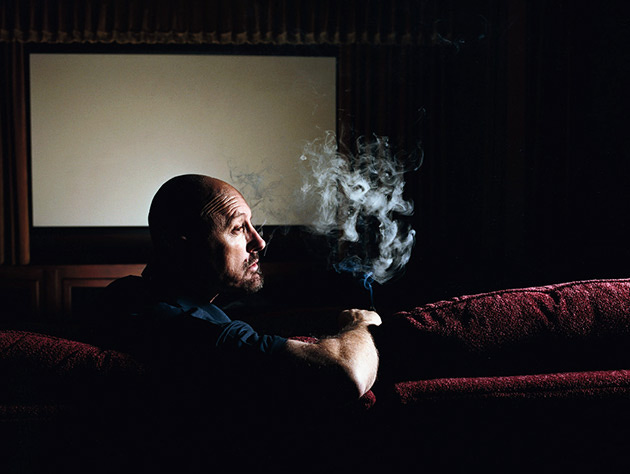
Photo of Jim Jannard, courtesy of Wired.
An exit from Oakley and the start of a new frontier
There are a few key dates we need to establish from Jim Jannard's career:
To create the world’s most powerful (digital) cinema camera.
“Insane.” “Crazy.” “Stupid.” These were the words lobbed at Jannard when he first spoke of his dream — and they weren’t exactly wrong. Film cameras had a 95% share of the cinema market at the time, while digital hovered around 5% at best.
Jim seemed to be dreaming up the impossible, but that didn’t stop him.
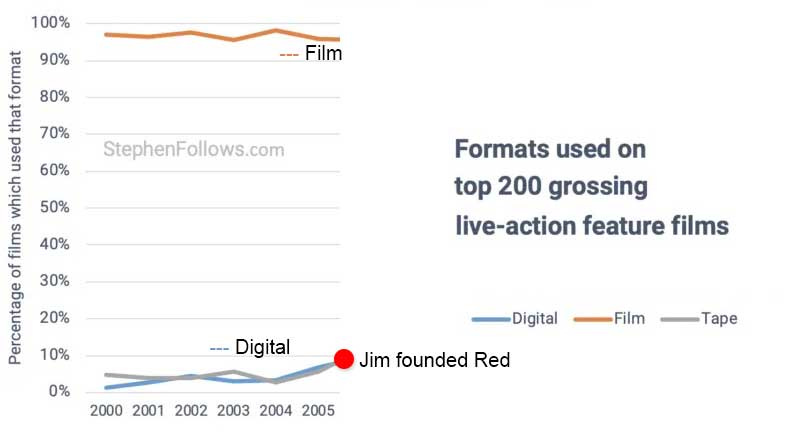
Digital overtaking film? It was the most impossible of tasks in 2005. Credit: Stephen Follows (subscribe to his Substack).
The Heist (or making the impossible, possible)
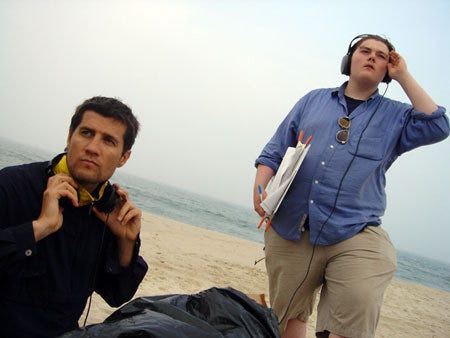
Courtesy of Frederic Lumière
Lumière HD had built a legion of supporters after years of exhibiting their products within the tech world. Their supporters included Apple, Sony, JVC, and one eccentric, idealistic billionaire...
Phase 1: The billion-dollar email
"I was helping out with IT support for Lumière HD, and one day I got this email", Fred explains.

Sliding into DMs ‘04 style (email recreated based on our interview with Fred)
Jim and Fred continued to chat over email for the next few days. "What started as a support chat escalated into a discussion of crazy ideas. It was relentless."
Like Jim, Fred dreamt of creating a camera that could rival analog. After all, a movie shot on an ARRIFLEX 35II made in 1960 could still provide a great image 60 years later. Why couldn't digital do the same?
"If you're interested, I would love to partner with you to build this camera. Give me a budget on how much you think it would cost," said Jim, before asking Fred to meet him — the very next day.
Jim lived in southern California, and Fred lived on the East coast. A good 3,000 miles separated the pair, but the following morning, Fred was on the next flight out. Little did he know he was about to embark on the greatest heist in cinema history.
Phase 2: Assembling the O-Team
Fred arrives in California and gives Jim a figure. The figure was the budget to undertake the entire project from start to finish: camera development costs, costs of the crew, everything.
It was a large number, but Jim wasn’t expecting to hear a small sum. The deal was agreed.
Despite the emails, Fred flying cross-country, and meeting Jim in person, it still didn't seem real. The next day Fred's wife — who was the CFO of Lumière HD at the time — called Fred and said, "Honey, we've just received a sh*t ton of money, do you know about this?"
Jim had sent the money straight to the company account. No contract. No invoice. Just sent...
And so the job began. The task was simple on paper: to create a digital camera that would not only compete with film but render it obsolete. The only way to steal film’s Hollywood customers was to ensure that digital was the hands-down better option.
So who were they up against?
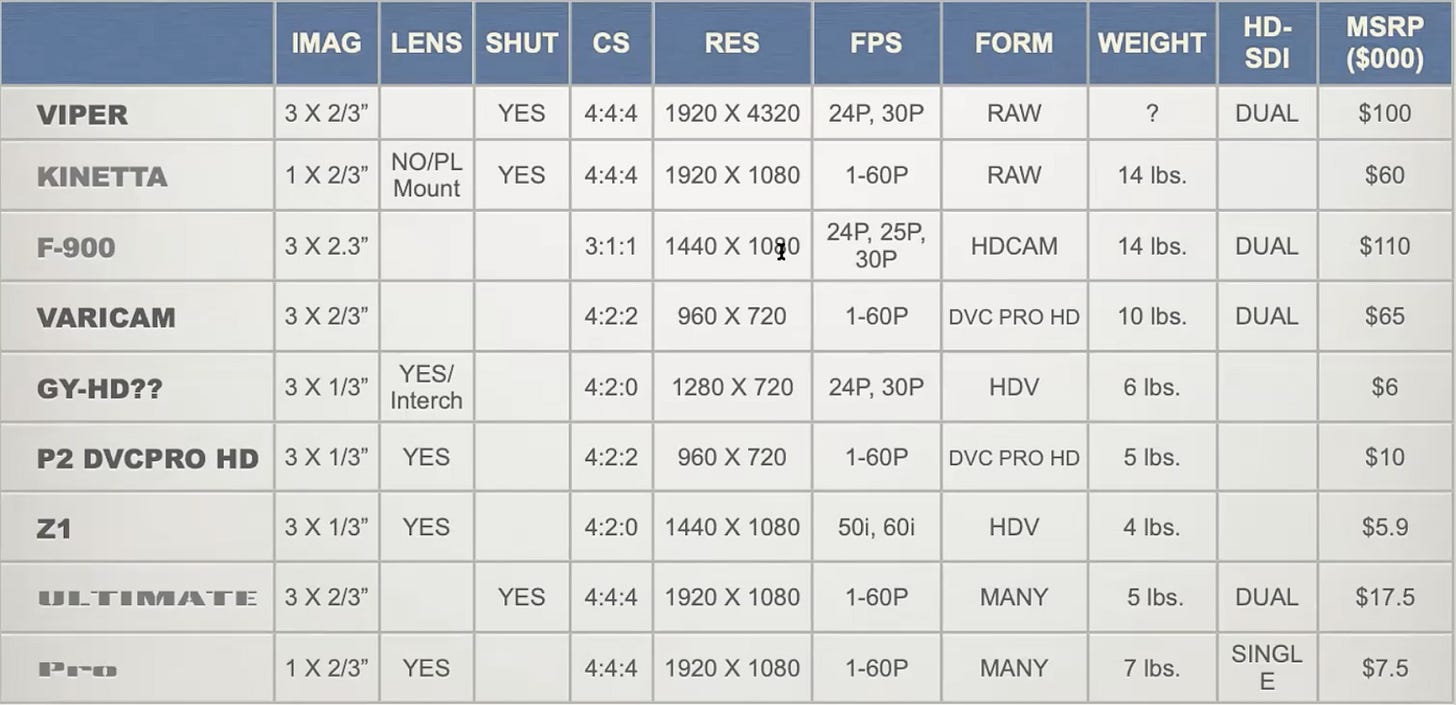
ULTIMATE and Pro were the initial O-cam prototypes. Courtesy: Frederic Lumière
Between the prices and specs, you can see that the O-Cam’s early prototypes ‘ULTIMATE’ and ‘Pro’ were unrivaled. The cameras would offer 4K resolution for less and yet were still comparable with the smaller HDV cameras in size and price.
To pull it off, Fred couldn’t just assemble the best camera tech individuals. He had to hire experts that defied categories and challenged the status quo. He needed people who were in-betweeners. Outsiders.
He needed to put together The O-Team:

Courtesy: Graeme Nattress
In early 2005, Fred flew to Tokyo and ran into old friend Ted Schilowitz who ran a booth for AJA systems. While Ted had an encyclopedic knowledge of cameras and software tech, developing the O-Cam was a challenge the likes of which he’d never faced before. And yet he was the perfect candidate in Fred’s eyes.
Ted was asked to create a digital camera that could output an image as good as…..be smaller than…....and cost less than…..film. All three elements needed to happen at the same time and Ted was skeptical.

Ted Schilowitz at NAB. Courtesy: Casey Green
Even if it were possible to create all the camera components, the real trick was creating a light-sensitive chip powerful and compact enough to replace film’s output. It wasn’t impossible, technically. But achieving this required two things:
After months of dead ends, Jim rings Ted directly and says: “It’s time”. While hesitant, Ted wasn’t going to say no at the chance of potentially making history. Ted joined and became The O-Team’s in-house “leader of the rebellion”.
No joke. That’s what his business card actually read.
By the time mid-2005 rolled around, each of the O-Team’s members had been given their role:
PHASE 3: Inventing MYSTERIUM and REDCODE
Graeme knew cameras on a scientific level better than anyone else. With him on board, the team managed to invent the groundbreaking MYSTERIUM sensor. It enabled 60 frames per second at 4K (and even up to 120fps if shooting in 2k resolution.)
The sensor was only half the battle, though. The team still lacked any hardware capable of reading the output — until Graeme helped invent REDCODE RAW.
Without REDCODE, RED does not exist. REDCODE enabled 6K footage to live on a disk a mere 5cm long and 1cm wide. And while the RED ONE camera could have shaken up the industry on its own, it was the ability for users to record cinema-level HD footage onto such a small disk that changed the game entirely.
RED now had the team, the tech, and the camera — the big day was fast arriving. The last step was to reveal the camera to the world.
https://substackcdn.com/image/fetch...46d45-9464-4a36-9d7b-d5a970327fa2_350x210.png
Phase 4: The grand (faked) reveal
At this stage in the process, Frederic ‘The Connector’ Lumière had stepped away from RED for around half a year — he needed to focus on other commitments. But when Jim called him up and said, "We're ready to unveil RED to the world, and I want you to present it.”... Well, Fred couldn’t turn the opportunity down.
However, all the camera tech and best crew in the world wouldn’t sell a single camera. They needed a grand reveal.
And what better place to do that than the NAB show?
NAB (National Association of Broadcasters) is the premier event for US camera technicians. It’s where the Sonys, the JVCs, and now the REDs of the world exhibit their new video gadgetry. In the months leading up to NAB 2006, early fans of RED’s mission had no clue what the cost of the first camera would be. Jim and the team decided to keep it a complete secret. As the crew flew to Las Vegas for the show, Fred created a fake price for the RED ONE as he feared other passengers would see the actual cost (Goodbye, big reveal, hello fresh competition!).
Fast forward to the presentation, though, and Fred’s about to deliver the slides when he realizes he didn't remove the fake price: $57,500.
“Tell the truth,” says Jim. Fred’s nervous, but he concedes.
As he hovers over and highlights the ‘5’ ready to make the change, the bustling crowd has no idea what the result will be. The expectation was that a number towards $100,000 would feel about right for a high-end digital camera at the time, but who knows — after all, this camera is revolutionary. Fred reveals the last digit.
$17500
The floor ERUPTS. No one could believe what they were seeing. And yet, quietly, people knew they were witnessing a new era of change. A digital revolution was well on its way.
While the camera was still a prototype, more than 500 people slapped down $1,000 deposits to join the waiting list. The industry still didn’t know if RED was a genuine company yet. Word on the street said it was all smoke and mirrors.
Jim and his team had the support of the camera techies, but that wasn’t enough. To complete the job, RED needed Hollywood to leap on the wagon.
And that was a mighty leap indeed.
Phase 5: Hollywood: the final frontier

The RED MX used on Pirates of the Caribbean: On Stranger Tides. Courtesy: Walt Disney Studios.
Hollywood Hall of Famer, Peter Jackson, was one of the first big hitters to transition over. In 2007, he got a hold of the RED ONE prototype to film his WWI short ‘Crossing the Line’.
More high-profile directors followed. And while RED was performing its own ‘Ocean’s Eleven’ style heist in hijacking Hollywood, the film’s director, Steven Soderbergh, was also one of RED’s early adopters.
He saw Jackson's short and immediately got himself two RED ONEs to shoot his biopic ‘Che’ in 2008. By the end of the year, RED had been used on more than 40 Hollywood feature films.
Just five years later, Hollywood’s biggest films were all being shot on RED — including Transformers, The Hobbit trilogy, and The Pirates of the Caribbean. Today, nearly 70% of Netflix original productions are shot on a RED device.
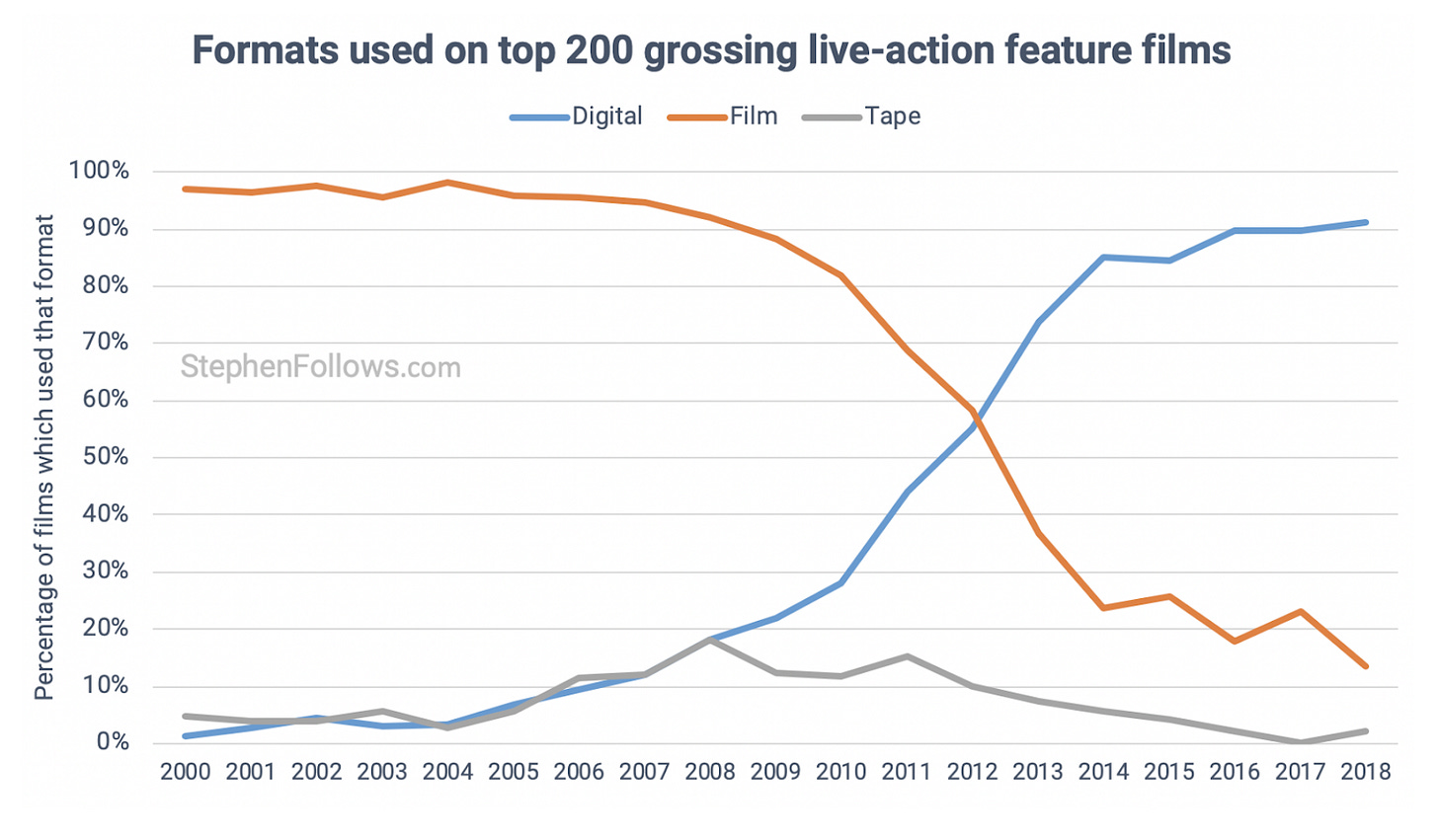
Remember that graph from earlier? Look what happened in 2012.
Without RED, digital cinema simply would not exist. It allowed indie filmmakers to produce cinema-ready films at a-tenth of the cost.
Film cameras had a stronghold on cinema for well over 100 years, and we are only about 10 years into the digital revolution. There is so much more to come — and that's thanks to RED.
They didn't just create a camera. They created a culture.
Epilogue: Where are the O-Team now?
Jim Jannard took a step back from RED in 2013, with Jarred Land taking his place as CEO. In 2019 he decided to retire completely, following "over 45 years of innovating technology through art."
Ted Shilowitz also left RED in 2013 and is now the resident "Futurist" at Paramount Global. He explores new forms of technologies — with a focus on virtual reality and Augmented Reality.
After 16 years, Graeme Nattress is still RED's in-house "Problem Solver". It’s his mission to keep RED innovating throughout the years — and he also runs his own plugin company, too.
Frederic Lumière took a back seat from RED soon after it launched and now runs APIANT. He went from connecting the key players at RED to creating a company that allows users to connect systems.

The sunglasses billionaire who got Hollywood to leave film behind
A tale of disruption, of outsiders breaking in, and of how a single piece of technology can rewrite the rules.

RED One prototype at NAB 2006.
The sunglasses billionaire who got Hollywood to leave film behind
A tale of disruption, of outsiders breaking in, and of how a single piece of technology can rewrite the rules.
Welcome to The Rough Cut by Eddie AI, a newsletter for people who think about video and storytelling as much as we do. You may have signed up to Eddie AI and already know about us or today is the first time. Either way, we’re glad you’re here.
This is our first newsletter.
Every week, we will break down the trends, techniques, and shifts shaping the production industry.
And once a month, we go deep. Our long-form story—think of it as a magazine in your inbox—dives into the creative and technical forces that shaped the way we make and watch video.
This month’s deep dive comes from Efosa Osaghae, a filmmaker and storyteller who knows the industry inside and out. It’s the story of how a sunglasses entrepreneur and his band of industry outsiders changed cinema forever. It’s a tale of disruption, of outsiders breaking in, and of how a single piece of technology can rewrite the rules.
Thanks for reading The Rough Cut! Subscribe for free to receive our weekly newsleter
Subscribed
As we stand on the brink of another major shift in filmmaking, let’s look back at a moment when technology redefined how we tell stories.
What would you say if we told you that one of the most influential camera companies of all time—RED—wasn’t just created by a Hollywood outsider, but by someone with zero film experience at all? Nearly 20 years ago, Jim Jannard, the billionaire founder of Oakley (yep, the sunglasses brand), and his team of industry bandits changed cinema forever. And hardly anyone knows what really happened behind the scenes...

Photo of Jim Jannard, courtesy of Wired.
An exit from Oakley and the start of a new frontier
There are a few key dates we need to establish from Jim Jannard's career:- He founded Oakley in 1976 — naming the company after his English setter, he took his first steps in business by selling motorcycle parts out of his van.
- In the 1980s, Jannard turned his attention to sports equipment, apparel, and the sunglasses Oakley is famous for today.
- By 1995, Oakley had gone public, raising $230 million in the process.
- And lastly, in 2007, Jim sold the company for $2.1 billion to Italian eyewear manufacturer Luxottica.
To create the world’s most powerful (digital) cinema camera.
“Insane.” “Crazy.” “Stupid.” These were the words lobbed at Jannard when he first spoke of his dream — and they weren’t exactly wrong. Film cameras had a 95% share of the cinema market at the time, while digital hovered around 5% at best.
Jim seemed to be dreaming up the impossible, but that didn’t stop him.

Digital overtaking film? It was the most impossible of tasks in 2005. Credit: Stephen Follows (subscribe to his Substack).
The Heist (or making the impossible, possible)
- The objective: Creating an impossible digital camera — comparable in image quality to film but for a lower price and in a smaller size.
- The target: Making digital the dominant mode of Hollywood filmmaking.
- Chances of pulling it off? Next to nil, until...

Courtesy of Frederic Lumière
Lumière HD had built a legion of supporters after years of exhibiting their products within the tech world. Their supporters included Apple, Sony, JVC, and one eccentric, idealistic billionaire...
Phase 1: The billion-dollar email
"I was helping out with IT support for Lumière HD, and one day I got this email", Fred explains.
Sliding into DMs ‘04 style (email recreated based on our interview with Fred)
Jim and Fred continued to chat over email for the next few days. "What started as a support chat escalated into a discussion of crazy ideas. It was relentless."
Like Jim, Fred dreamt of creating a camera that could rival analog. After all, a movie shot on an ARRIFLEX 35II made in 1960 could still provide a great image 60 years later. Why couldn't digital do the same?
"If you're interested, I would love to partner with you to build this camera. Give me a budget on how much you think it would cost," said Jim, before asking Fred to meet him — the very next day.
Jim lived in southern California, and Fred lived on the East coast. A good 3,000 miles separated the pair, but the following morning, Fred was on the next flight out. Little did he know he was about to embark on the greatest heist in cinema history.
Phase 2: Assembling the O-Team
Fred arrives in California and gives Jim a figure. The figure was the budget to undertake the entire project from start to finish: camera development costs, costs of the crew, everything.It was a large number, but Jim wasn’t expecting to hear a small sum. The deal was agreed.
Despite the emails, Fred flying cross-country, and meeting Jim in person, it still didn't seem real. The next day Fred's wife — who was the CFO of Lumière HD at the time — called Fred and said, "Honey, we've just received a sh*t ton of money, do you know about this?"
Jim had sent the money straight to the company account. No contract. No invoice. Just sent...
And so the job began. The task was simple on paper: to create a digital camera that would not only compete with film but render it obsolete. The only way to steal film’s Hollywood customers was to ensure that digital was the hands-down better option.
So who were they up against?

ULTIMATE and Pro were the initial O-cam prototypes. Courtesy: Frederic Lumière
Between the prices and specs, you can see that the O-Cam’s early prototypes ‘ULTIMATE’ and ‘Pro’ were unrivaled. The cameras would offer 4K resolution for less and yet were still comparable with the smaller HDV cameras in size and price.
To pull it off, Fred couldn’t just assemble the best camera tech individuals. He had to hire experts that defied categories and challenged the status quo. He needed people who were in-betweeners. Outsiders.
He needed to put together The O-Team:
- Graeme Nattress
- Ted Schilowitz
- Frederic Lumière
- Jim Jannard

Courtesy: Graeme Nattress
In early 2005, Fred flew to Tokyo and ran into old friend Ted Schilowitz who ran a booth for AJA systems. While Ted had an encyclopedic knowledge of cameras and software tech, developing the O-Cam was a challenge the likes of which he’d never faced before. And yet he was the perfect candidate in Fred’s eyes.
Ted was asked to create a digital camera that could output an image as good as…..be smaller than…....and cost less than…..film. All three elements needed to happen at the same time and Ted was skeptical.

Ted Schilowitz at NAB. Courtesy: Casey Green
Even if it were possible to create all the camera components, the real trick was creating a light-sensitive chip powerful and compact enough to replace film’s output. It wasn’t impossible, technically. But achieving this required two things:
- A billion-dollar electronics company with the resources to let genius camera scientists experiment in labs for months on end.
- An owner brave (or brilliant) enough to let No.1 take place.
After months of dead ends, Jim rings Ted directly and says: “It’s time”. While hesitant, Ted wasn’t going to say no at the chance of potentially making history. Ted joined and became The O-Team’s in-house “leader of the rebellion”.
No joke. That’s what his business card actually read.
By the time mid-2005 rolled around, each of the O-Team’s members had been given their role:
- Graeme: The Scientist
- Ted: The Rebel
- Fred: The Connector
- Jim: The Madman
PHASE 3: Inventing MYSTERIUM and REDCODE
Graeme knew cameras on a scientific level better than anyone else. With him on board, the team managed to invent the groundbreaking MYSTERIUM sensor. It enabled 60 frames per second at 4K (and even up to 120fps if shooting in 2k resolution.)The sensor was only half the battle, though. The team still lacked any hardware capable of reading the output — until Graeme helped invent REDCODE RAW.
Without REDCODE, RED does not exist. REDCODE enabled 6K footage to live on a disk a mere 5cm long and 1cm wide. And while the RED ONE camera could have shaken up the industry on its own, it was the ability for users to record cinema-level HD footage onto such a small disk that changed the game entirely.
RED now had the team, the tech, and the camera — the big day was fast arriving. The last step was to reveal the camera to the world.
https://substackcdn.com/image/fetch...46d45-9464-4a36-9d7b-d5a970327fa2_350x210.png
Phase 4: The grand (faked) reveal
At this stage in the process, Frederic ‘The Connector’ Lumière had stepped away from RED for around half a year — he needed to focus on other commitments. But when Jim called him up and said, "We're ready to unveil RED to the world, and I want you to present it.”... Well, Fred couldn’t turn the opportunity down.However, all the camera tech and best crew in the world wouldn’t sell a single camera. They needed a grand reveal.
And what better place to do that than the NAB show?
NAB (National Association of Broadcasters) is the premier event for US camera technicians. It’s where the Sonys, the JVCs, and now the REDs of the world exhibit their new video gadgetry. In the months leading up to NAB 2006, early fans of RED’s mission had no clue what the cost of the first camera would be. Jim and the team decided to keep it a complete secret. As the crew flew to Las Vegas for the show, Fred created a fake price for the RED ONE as he feared other passengers would see the actual cost (Goodbye, big reveal, hello fresh competition!).
Fast forward to the presentation, though, and Fred’s about to deliver the slides when he realizes he didn't remove the fake price: $57,500.
“Tell the truth,” says Jim. Fred’s nervous, but he concedes.
As he hovers over and highlights the ‘5’ ready to make the change, the bustling crowd has no idea what the result will be. The expectation was that a number towards $100,000 would feel about right for a high-end digital camera at the time, but who knows — after all, this camera is revolutionary. Fred reveals the last digit.
$17500
The floor ERUPTS. No one could believe what they were seeing. And yet, quietly, people knew they were witnessing a new era of change. A digital revolution was well on its way.
While the camera was still a prototype, more than 500 people slapped down $1,000 deposits to join the waiting list. The industry still didn’t know if RED was a genuine company yet. Word on the street said it was all smoke and mirrors.
Jim and his team had the support of the camera techies, but that wasn’t enough. To complete the job, RED needed Hollywood to leap on the wagon.
And that was a mighty leap indeed.
Phase 5: Hollywood: the final frontier

The RED MX used on Pirates of the Caribbean: On Stranger Tides. Courtesy: Walt Disney Studios.
Hollywood Hall of Famer, Peter Jackson, was one of the first big hitters to transition over. In 2007, he got a hold of the RED ONE prototype to film his WWI short ‘Crossing the Line’.
More high-profile directors followed. And while RED was performing its own ‘Ocean’s Eleven’ style heist in hijacking Hollywood, the film’s director, Steven Soderbergh, was also one of RED’s early adopters.
He saw Jackson's short and immediately got himself two RED ONEs to shoot his biopic ‘Che’ in 2008. By the end of the year, RED had been used on more than 40 Hollywood feature films.
Just five years later, Hollywood’s biggest films were all being shot on RED — including Transformers, The Hobbit trilogy, and The Pirates of the Caribbean. Today, nearly 70% of Netflix original productions are shot on a RED device.

Remember that graph from earlier? Look what happened in 2012.
Without RED, digital cinema simply would not exist. It allowed indie filmmakers to produce cinema-ready films at a-tenth of the cost.
Film cameras had a stronghold on cinema for well over 100 years, and we are only about 10 years into the digital revolution. There is so much more to come — and that's thanks to RED.
They didn't just create a camera. They created a culture.
Epilogue: Where are the O-Team now?
Jim Jannard took a step back from RED in 2013, with Jarred Land taking his place as CEO. In 2019 he decided to retire completely, following "over 45 years of innovating technology through art."Ted Shilowitz also left RED in 2013 and is now the resident "Futurist" at Paramount Global. He explores new forms of technologies — with a focus on virtual reality and Augmented Reality.
After 16 years, Graeme Nattress is still RED's in-house "Problem Solver". It’s his mission to keep RED innovating throughout the years — and he also runs his own plugin company, too.
Frederic Lumière took a back seat from RED soon after it launched and now runs APIANT. He went from connecting the key players at RED to creating a company that allows users to connect systems.
RED Cuts V-Raptor X Starting Price in Half With Streamlined XE Cinema Camera
A much more accessible entry to the RED V-Raptor X system.

